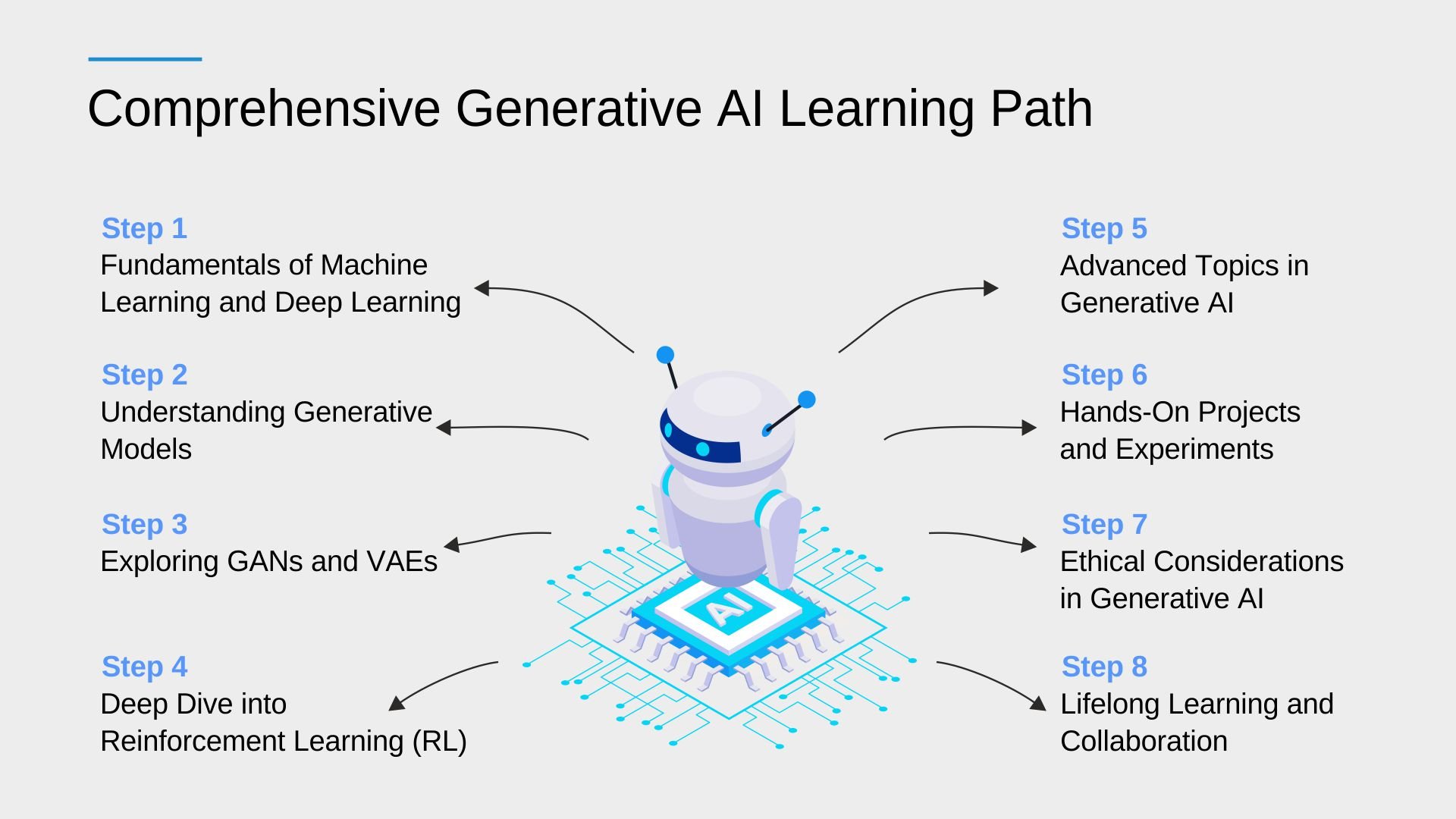Generative Artificial Intelligence (AI) is a rapidly evolving field that has opened up exciting opportunities in the realm of creativity and innovation. Whether you’re an aspiring AI researcher, a developer, or a creative professional looking to incorporate AI into your work, embarking on a well-structured learning path can help you navigate the intricacies of generative AI and unleash your creative potential. In this blog, we present a comprehensive Generative AI Learning Path that will guide you through the essential concepts, tools, and techniques required to master this fascinating field.

Step 1: Fundamentals of Machine Learning and Deep Learning
To embark on your Generative AI journey, it’s crucial to have a strong foundation in machine learning and deep learning. Start by familiarizing yourself with the basic concepts of supervised and unsupervised learning, neural networks, and optimization algorithms. Dive deeper into deep learning frameworks such as TensorFlow or PyTorch, and gain hands-on experience with building and training neural networks for classification and regression tasks.
Step 2: Understanding Generative Models
Next, delve into the realm of generative models. Study the underlying principles and architectures of popular generative models like Generative Adversarial Networks (GANs), Variational Autoencoders (VAEs), and Autoregressive Models. Learn how these models can generate realistic images, texts, and music by capturing complex data distributions.
Step 3: Exploring GANs and VAEs
Dedicate time to exploring the inner workings of GANs and VAEs, two of the most influential generative models. Understand how GANs leverage a generator-discriminator framework to produce realistic data samples and discover techniques for improving GAN stability and mode collapse. Simultaneously, grasp the probabilistic nature of VAEs and learn how to encode and decode data into a continuous latent space.
Step 4: Deep Dive into Reinforcement Learning (RL)
Expand your generative AI knowledge by incorporating reinforcement learning techniques. Study the fundamentals of RL, including Markov Decision Processes, policy gradients, and value functions. Explore how RL can be used to train agents to generate content interactively, such as game characters or dialogue systems.
Step 5: Advanced Topics in Generative AI
Once you have a solid understanding of the foundational concepts, venture into advanced topics in generative AI. Delve into topics like style transfer, domain adaptation, and multi-modal generation. Explore cutting-edge research papers and attend conferences to stay updated on the latest advancements in the field.
Step 6: Hands-On Projects and Experiments
Put your knowledge into practice by working on hands-on projects and experiments. Start with small-scale projects, such as generating images or text samples. As you gain confidence, challenge yourself with more complex tasks like creating deepfake videos or designing interactive generative art installations. Actively participate in online communities and share your projects to receive feedback and learn from fellow enthusiasts.
Step 7: Ethical Considerations in Generative AI
Generative AI raises important ethical considerations, including privacy, bias, and misuse of generated content. Take the time to explore the ethical dimensions of generative AI and develop a responsible mindset toward its applications. Stay informed about ethical guidelines and contribute to discussions on the responsible use of AI.
Step 8: Lifelong Learning and Collaboration
Generative AI is a rapidly evolving field, and continuous learning is essential to stay at the forefront of innovation. Engage in lifelong learning by exploring new research papers, attending workshops, and participating in online courses. Collaborate with other AI enthusiasts, join forums and communities, and contribute to open-source projects to foster a vibrant learning ecosystem.
Conclusion
The Generative AI Learning Path presented here provides a comprehensive roadmap for anyone interested in mastering the art of creative AI. By building a strong foundation in machine learning and deep learning, exploring generative models, and engaging in hands-on projects, you’ll gain the necessary skills to generate new and innovative content. Remember to approach generative AI with an ethical mindset, embracing responsible practices to ensure the positive impact of AI on society. So, buckle up, embark on this exciting learning journey, and unleash your creative potential with generative AI!
Topics: technologies, IoT, DevOps, workflow automation, AI